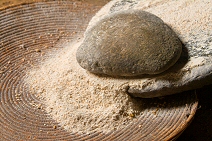Injera - Ethiopian Flat Bread Recipe

Injera is a traditional Ethiopian flat bread which can be made from several types of flour depending on the location of the bread baker. Injera is also called enjera, laxoox, lahoh or canjeero. Some of the flours used in making injera are teff, whole wheat flour, barley, rice, and/or corn meal. Teff is the flour of choice for injera. However, since the growing of this iron rich grain is limited to certain elevations and a particular amount of rainfall. Teff can be hard to come by and also very expensive.
Injera is cooked on a large clay plate (called a mogogo) over a fire although electric skillets are also used. A very large crepe-like bread is created. Injera is only cooked on one side and is not allowed to brown on the cooked side. Since this bread is so thin, both sides are cooked in the final product.
Injera is almost never eaten by itself. The large flat bread is placed on the table and other food is placed on top of the injera. Injera becomes the plate, the eating utensil, and the food. Pieces of injera are ripped off the main bread and used to scoop or pickup the other foods such as stews and salads. The injera soaks up the juices and flavors from the food placed upon it. As the meal continues, the table becomes empty of all food.
If you are a guest at a meal in Ethiopia, don't be surprised if someone tries to feed you some food. This is done as a sign of respect.

Injera Recipe:
1 1/2 cups ground teff
2 cups water
salt, to taste
vegetable oil, for the skillet
Mix the ground teff and water together in a bowl with salt to taste. Make sure there are no lumps. Put aside for one to three days to allow the dough to ferment. This is when the injera acquires its tangy, slightly sour taste.
Heat up a skillet, adding a little oil so the injera doesn't stick. The injera dough should be loose like a pancake or crepe batter. Pour some batter or dough on the hot skillet covering the entire cooking surface. The injera should be thicker than a crepe, but not as thick as a pancake.
Allow the injera to cook. Little bubbles will rise to the surface. Once the top in the injera is dry it's done. You only cook one side of this bread and you don't allow the injera to brown on the cooked side.
Substitutions and Additions:
You may substitute other flours such as rice flour, whole wheat flour, or corn meal for the teff flour. Some people use half self-rising flour and another flour.
Sometimes club soda is used instead of water. This gives the dough faster start in the fermentation process - sort of like a sour dough starter.
Yeast may also be added to the recipe to help the dough rise.
Teff Flour is available at Amazon.com
Injera is cooked on a large clay plate (called a mogogo) over a fire although electric skillets are also used. A very large crepe-like bread is created. Injera is only cooked on one side and is not allowed to brown on the cooked side. Since this bread is so thin, both sides are cooked in the final product.
Injera is almost never eaten by itself. The large flat bread is placed on the table and other food is placed on top of the injera. Injera becomes the plate, the eating utensil, and the food. Pieces of injera are ripped off the main bread and used to scoop or pickup the other foods such as stews and salads. The injera soaks up the juices and flavors from the food placed upon it. As the meal continues, the table becomes empty of all food.
If you are a guest at a meal in Ethiopia, don't be surprised if someone tries to feed you some food. This is done as a sign of respect.

Injera Recipe:
1 1/2 cups ground teff
2 cups water
salt, to taste
vegetable oil, for the skillet
Mix the ground teff and water together in a bowl with salt to taste. Make sure there are no lumps. Put aside for one to three days to allow the dough to ferment. This is when the injera acquires its tangy, slightly sour taste.
Heat up a skillet, adding a little oil so the injera doesn't stick. The injera dough should be loose like a pancake or crepe batter. Pour some batter or dough on the hot skillet covering the entire cooking surface. The injera should be thicker than a crepe, but not as thick as a pancake.
Allow the injera to cook. Little bubbles will rise to the surface. Once the top in the injera is dry it's done. You only cook one side of this bread and you don't allow the injera to brown on the cooked side.
Substitutions and Additions:
You may substitute other flours such as rice flour, whole wheat flour, or corn meal for the teff flour. Some people use half self-rising flour and another flour.
Sometimes club soda is used instead of water. This gives the dough faster start in the fermentation process - sort of like a sour dough starter.
Yeast may also be added to the recipe to help the dough rise.
Teff Flour is available at Amazon.com
This site needs an editor - click to learn more!
You Should Also Read:
Forum Discussion - African Bread
Teff - Staple Grain of Ethiopia
Buhé - Ethiopia's Halloween
Related Articles
Editor's Picks Articles
Top Ten Articles
Previous Features
Site Map
Content copyright © 2023 by Jeanne Egbosiuba Ukwendu. All rights reserved.
This content was written by Jeanne Egbosiuba Ukwendu. If you wish to use this content in any manner, you need written permission. Contact
BellaOnline Administration
for details.


